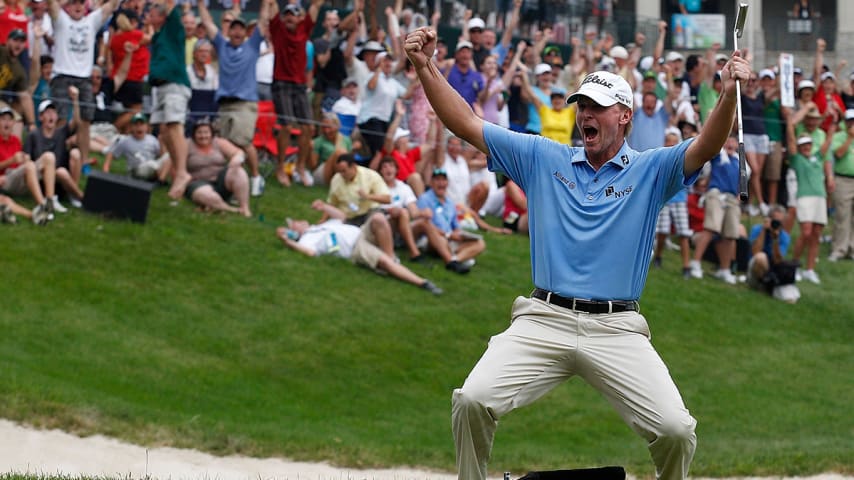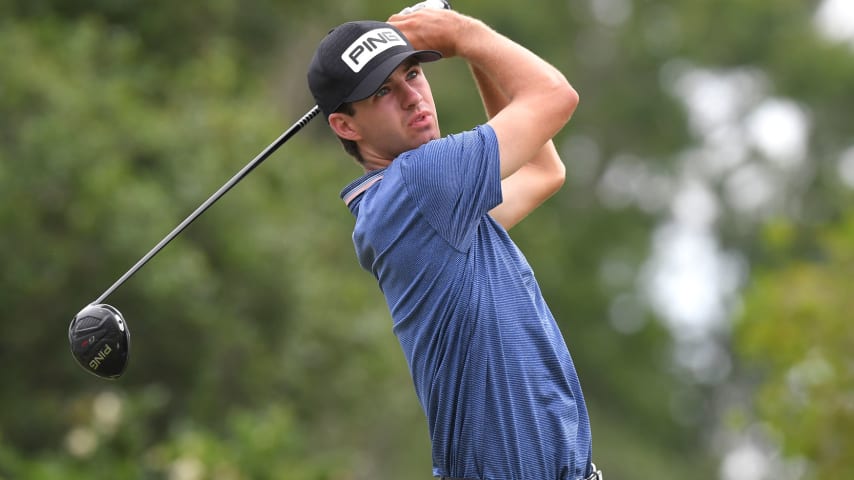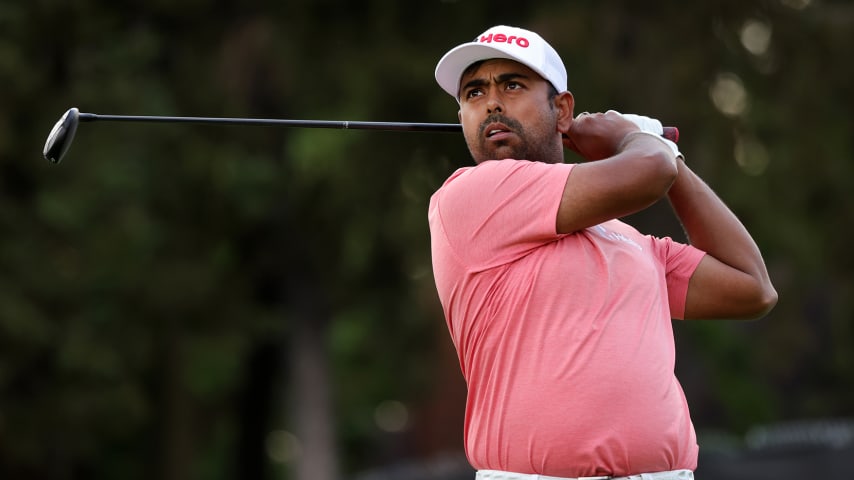‘Most over-achieving event in history of TOUR’ prepares to turn 50
13 Min Read

‘Most over-achieving event in history of TOUR’ prepares to turn 50
Written by Craig DeVrieze
‘Most over-achieving event in history of TOUR’ prepares to turn 50
In September of 1920, the Rock Island Independents hosted, and won, the first game in the history of the American Professional Football Association. A week later, the Moline Universal Tractors traveled to central Illinois, where they were soundly beaten by a George Halas-coached bunch called the Decatur Staleys.
By 1922, the APFA had been renamed the National Football League; Halas’ Staleys were bearing down in Chicago; the Universal Tractors were out of the game; and the Independents weren’t long for the leather-headed new world of professional football.
In 1949, the Red Auerbach-coached Tri-Cities Blackhawks helped usher the National Basketball Association into existence, playing in a 4,000-seat high school barn in Moline. A year later, the Blackhawks drafted a point guard named Bob Cousy but neglected to offer a contract. By 1952, Auerbach and Cousy were together, launching a pro hoops dynasty in Boston. The Blackhawks had moved on, first to Milwaukee, then St. Louis. Today, they are called the Atlanta Hawks.
Given the nomadic nature of early professional sports, Rock Island, Moline and the collection of Iowa-Illinois border communities known today as the Quad Cities would be far from alone in wistfully wondering what might have been.
Myriad mid-sized Midwest cities — Canton and Dayton in Ohio, Fort Wayne and Hammond in Indiana, Sheboygan and Green Bay in Wisconsin, to name a few — also own foundational roles in pro sports leagues that quickly outgrew all but one.
As the lone survivor, the Packers of Green Bay are one of the remarkable stories in all of professional sports. Across the Rust Belt, they serve as the example of what could have been.
Yet, while other left-behind locales continue to wonder, the Quad Cities’ major league dreams didn’t disappear with the Independents, Tractors and Blackhawks.
Since professional golf first put a tee in the ground in Bettendorf, Iowa, in 1971, Quad Citians tenaciously have clung — time and again, often against all odds — to their one last swing at the Bigs.
With apologies to Packers (and the Spacklers), this is a Cinderella story, too.
What started as the Quad Cities Open and is celebrated today as the John Deere Classic will turn an improbable 50 this July. The tournament stands as a tribute to spirit, resilience and determination and the staggering impact professional golf can have on a community.
The John Deere Classic celebrates its golden anniversary having withstood no fewer than five near-death moments, including at the tender age of 4, when an April 1975 news release announcing its demise was issued and then promptly rescinded. Nine years later, only a volunteer’s promise to cover a $350 debt to a local printer spared the tournament from bankruptcy.
Money -- or rather a dearth of it – was most often the issue, resulting from the lack of an invested title sponsor. Early purses were among the smallest on TOUR. Network TV wasn’t a thought. Survival was a near-annual discussion.
Time and again, though, the hardscrabble, homespun, Cinderella-in-spikes Quad Cities Open battled on.
In 1975, a hardcore crew of Jaycees who’d later concede they were too young to know better pulled the fledgling tournament out of the trash and replaced it with crumpled copies of that foreboding news release. In less than two months, they found both a new Pete Dye-designed golf course and a B-List celebrity host for the Jaycees-Ed McMahon Quad Cities Open.
Over the ensuing four years, McMahon would bring Bob Hope, Jerry Lewis and a cavalcade of showbiz chums straight from Johnny Carson’s “Tonight Show” couch to lend star power to a tournament largely overshadowed by the competing Open Championship an ocean away.
Meanwhile, golfers like 1975 winner Roger Maltbie and 1976 runner-up Fuzzy Zoeller knocked back post-round beers at Ed’s Place, the homemade bar situated behind the 18th green at the Dye-designed Oakwood Country Club in Coal Valley, Illinois.
It was a rollicking summer party until last call for Ed’s Place came after the 1979 QCO.
“I just had to give it up because every time I got somebody to play in my golf tournament, they wanted me to come to theirs,” the entertainer explained a decade later. “I had so many markers to pay back when the thing was over, I just couldn’t keep up.”
In 1984, the first official audit in tournament history uncovered debt in the six-figures. After a board vote on whether to fight on or file for bankruptcy deadlocked at 9 votes apiece, tournament supporters took to the phones nightly to solicit donations that retired much of the debt. Local creditors were asked to take dimes on dollars they were owed, and did.
“This was our Chicago Cubs,” said John Wetzel, that year’s volunteer chair whose personal promise on the aforementioned $350 printer’s debt averted a small claims summons that would have forced the board to file for bankruptcy. “We had a spot in the professional sporting community. Enough people bought into that vision to keep it going.”
A year later, the tournament was facing a self-imposed vow to increase the purse from $200,000 to $300,000. That meant replacing the insufficient $60,000 title-sponsor investment of a regional brewing company. The board mass-mailed 50 potential corporate backers, but the search came up empty. They found an option B, cobbling together funding from four local municipalities, a like amount of matching funds from the Illinois Tourism Bureau, and a $15,000 grant from the PGA TOUR to stay alive, if only for one year more.
On a shuttle en route to that year’s pro-am, Jim Jensen, a regional VP for Hardee’s Food Systems, Inc., saw a coupon for a competing burger chain on the back of his tournament ticket, remembered seeing a letter cross his desk months earlier asking for a title sponsorship, and wondered aloud: “Nobody else wants to come to the table. Hardee’s ought to sponsor this. And lots of people on the bus said, ‘Yeah. Why don’t you?’”
Thus, began nine years of long-sought stability for the tournament former TOUR executive Duke Butler refers to today as “the most over-achieving event in the history of the PGA TOUR.”
Overachievers and golf have a strong history in the Quad Cities.
Quad Cities native Jack Fleck was a Davenport municipal pro who played only occasionally on TOUR in the early 50s, and almost always with little success, until he ventured west in June of 1955 to compete in the U.S. Open at the Olympic Club in San Francisco.
Fleck famously returned a conquering hero, the Cinderella’s Cinderella, having birdied the 72nd hole to tie the legendary Ben Hogan. He outplayed the Hawk in an 18-hole playoff the next day, and brought the Open trophy home to a rousing reception.
The Quad Cities golf community still was buzzing over Fleck’s epic upset when the idea of bringing the PGA TOUR to town began to percolate. Avid golfers like Franklin “Whitey” Barnard, a high school teammate of Fleck’s, kicked around the notion of building a championship-caliber golf course that could challenge top professionals.
Step One was achieved when Crow Valley Country Club opened in 1969. Two years later, the Quad Cities Open debuted as one of several satellite events created to provide the so-called rabbits chasing opportunity on the non-exempt TOUR places to compete for beer and gas money between Monday qualifiers.
Deane Beman hoisted that first trophy, and won again the following year, edging a young runner-up named Tom Watson for the title of a Quad Cities Open that had graduated from a satellite stop to a fully-sanctioned PGA TOUR event.
Less than two years later, Beman set his clubs aside to succeed Joe Dey as TOUR commissioner, and he set out to make professional golf the big-league equal of North America’s Big Four — the NFL, NBA, Major League baseball, and the National Hockey League.
“I was a fan of other sports, and I realized the kind of income other athletes were making,” Beman said. “When I became commissioner, bowling got more TV money than golf did.”
Beman accomplished his big-league mission in a big, big way. From 1974 through Beman’s retirement in 1994, purses fueled by deep-pocketed corporate sponsors grew from a collective $8.16 million to a sum total of $56.14 million. Television revenues increased by 2,000%.
Within a decade, Beman built a major-league enterprise certain to challenge the survival of events in smaller communities like the Quad Cities. In fact, most like-sized cities that preceded or followed the Quad Cities on TOUR ultimately didn’t survive.
Through grit and determination, the Quad Cities continue to defy the odds.
Critical to the tournament’s survival has been a willingness to accept what the TOUR considers “disadvantaged dates.” The Quad Cities spent 16 years directly opposite the British Open and another 21 the week before or after.
The Hardee’s Golf Classic moved to September in 1990, but the burger chain withdrew its sponsorship after the 1994 event, and only an agreement for another “disadvantaged date” — playing opposite the Ryder and President Cups each fall — bought the Quad Cities event some time.
Yet that lifeline was unraveling in 1996, until a young hopeful making his third professional start took the 54-hole lead into the final round of what was then the Quad City Classic.
A grizzled veteran, Ed Fiori, eventually ran down the big-hitting youngster, denying the Quad Cities a chance to claim a place in golf history as home to Tiger Woods’ first PGA TOUR win. Still, Woods’ presence, as it was at so many events, was a boost.
Just shy of 150 years earlier, a Vermont-born blacksmith with a promising invention called the steel plow set up shop on the banks of the Mississippi in what would soon become Moline, Illinois.
John Deere’s steel plow was fundamental to the Quad Cities becoming the Farm Machinery Capital of the World.
By 1979, when Illinois’ D.A. Weibring won the last of the Ed McMahon-Jaycees Quad Cities Open, more than 52,000 Quad Citians were working around the clock in dozens of factories to produce farm equipment bearing the names of Case, Farmall, International Harvester and, of course, John Deere.
With its corporate headquarters based in nearby Moline, Deere was a title sponsor target from the moment the Quad Cities tournament teed off. And, to many, that seemed a natural fit. Two of the founder’s early descendants, after all, had a grand history in the game. Grandson John Deere Cady played on the silver-medalist U.S. men’s golf team at the 1904 Summer Olympics. And a cabin at Augusta National still bears the name of Deere’s great-nephew Burton Peek.
Still, Deere & Company did not grow into the Fortune 150 company it is today by investing in family pastimes. William Hewitt, the last in a line of Deere chairmen with a family tie to the founder, declined those 1970s asks for significant sponsorship dollars.
When the farm economy downturned on a dime in the midst of an epic recession in the 1980s, Case and IH turned out the lights on their Quad Cities-based factories, left town and took thousands of jobs with them. Deere remained but was far from immune to the economic realities of the recession. It was in no position through the 1980s to help a gritty little golf tournament fight for its life.
John Deere’s company turned its fate around, thanks to longstanding strategic commitments to global expansion and product diversification. That the latter included a golf and turf equipment product line started in 1985 is the lynchpin reason the Deere turns 50 this year.
Butler, the TOUR executive, helped put the over-achieving tournament over the top. The tournament was on its last legs in May 1996, when Butler and tournament officials traveled to Deere & Company headquarters for one last ask of the flagging event’s last best hope.
The Deere team was cordial but skeptical until Butler, son of a Texas cattle rancher loyal to Deere equipment, put an intriguing proposal on the table: Were Deere & Company to take on title sponsorship of the tournament, the TOUR would build a TPC course to host and John Deere would become the official golf course equipment supplier across the expanding TPC network.
Skepticism quickly waned at One John Deere Place, and negotiations were proceeding apace long before Fiori caught a Tiger by the tail in September.
In April of 1997 – the same month that the kid who lost to Fiori won the Masters by 12 -- the deal was sealed and announced.
As its golden anniversary nears, the John Deere Classic boasts the third longest title sponsor relationship on TOUR. In 2018 and 2019, the John Deere Classic and Deere won the TOUR’s year-end award for Best Title Sponsor Integration. The miniature tractors that serve as tee markers and the popular Big Dig, where players and their families get to test drive Deere products, are just two examples of the cohesive relationship between the tournament and sponsor.
The payback for those unrelenting volunteers who fought long and hard to keep the Classic on the calendar, meanwhile, has been immense. Since its introduction in 1992, the JDC’s high-flying, highly creative Birdies for Charity program has generated $133 million for well over 600 charitable organizations in the region. Thanks to the generous donations neighbors and local businesses annually make to soliciting charities, bolstered by a Deere- and tournament-funded bonus pool, the JDC has proudly owned the title of per capita leader in charitable giving on TOUR for a decade-plus.
In seven of the past 11 years, the JDC earned the TOUR’s Most Engaged Community Award, and the 2019 event was backed by 2,200 volunteers, more than double largest volunteer force to turn out at Oakwood.
Patrons continue to embrace the event for the one-week-per-year taste of the big leagues it presents.
The tournament’s long-embraced niche as a launching pad for TOUR stars has produced 23 first-time winners, among them Payne Stewart (1982), Scott Hoch (1980), David Toms (1997), and, most recently, Jordan Spieth (2013) and Bryson DeChambeau (2017).
Fans nearly witnessed the first wins of Woods and Tom Watson. And, in addition to seeing Woods take his first lead into a Sunday final round, they also saw Sam Snead, co-record-holder with Woods for most career TOUR wins, take his last lead into a Sunday in 1974.
Over 49 years and counting, Quad Citians have seen 15 of the 24 men who have held the top spot in the Official World Golf Rankings tee it up in their midst. They also have seen 26 of the 44 TOUR golfers inducted into the World Golf Hall of Fame over the past 50 years play through.
For a community that ranked behind 143 other U.S. Metropolitan Statistical Areas in the 2020 census, that’s pretty big stuff.
That’s a small community with little reason to regret big-league opportunities gone by.
Who needs the Universal Tractors, anyway?
Freelance writer Craig DeVrieze is the author of “Magic Happened: Celebrating 50 Years of the John Deere Classic,” available for order here.





